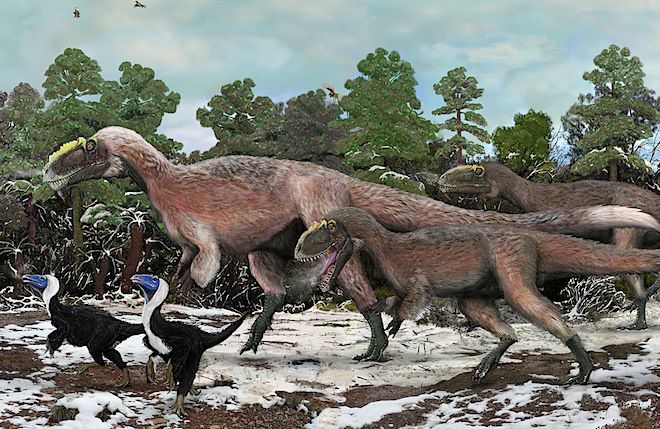Stop Scalewashing
Dinosaurs: Our feathered friends?
March 6, 2018
A lot of dinosaurs had feathers. That isn’t a theory anymore, it’s a hard scientific fact. All the raptors, the ostrich-like gallimimus and its relatives, archaeopteryx (it’s no longer considered the first bird–or even a bird at all)… there are plenty of confirmed feathered dinosaurs to list, even if all of them are not household names. Most people haven’t heard of Sinosauropteryx or Citipati There’s also a good chance Tyrannosaurus Rex had them too since the discovery of its close relative Yutyrannus (Pictured above) was discovered in China and found to have a full feathery coat. Even Triceratops has what could have possibly been quill knobs for a set of spiny feathers along its lower back and tail.
And for someone who deliberately keeps up to date on paleontology, absolutely none of this should be a surprise. It’s all old news. But to the general public who knows their dinosaurs from movies, television, and video games? I’ve received a large amount of surprised reactions from these people when I mention just how many dinosaurs had feathers. And that’s because popular culture seems to be rejecting the modern notion of feathered dinosaurs in favor of the old, scaly image they’ve grown used to. The only piece of entertainment I can think of that uses fully accurate dinosaurs is an early access game titled Saurian, which is deliberately constructed as the most accurate dinosaur-themed video game and as an indie game, isn’t designed to follow mass market trends. But why are accurately depicted dinosaurs so rare despite how long we’ve known about the feathers so many of them had?
Quite simply, nobody wants to break the mold. Change is scary and most people grew up on the image of giant lizards roaming the Earth. Everyone wants to follow what Jurassic Park did since that’s still the most iconic dinosaur movie. They’re worried that feathers aren’t “cool” enough for mainstream audiences.
However, this really is rather misguided. At the time of its release, Jurassic Park followed the latest scientific discoveries, not market trends. They didn’t portray dinosaurs as tail-dragging Godzilla lookalikes, they were built like actual animals, even if there was more than a little artistic license. Not to mention that in the context of the film (And even highlighted in the book it was based on), the dinosaurs aren’t meant to be accurate. They were made in a lab using all different kinds of DNA. Of course they’d look different! They aren’t real dinosaurs, they’re lab-engineered Frankenstein’s Monsters of genetics. There isn’t any excuse to follow deliberately inaccurate dinosaurs when there’s been so many new discoveries. Plus, feathers don’t exactly inspire the image of weakness- eagles, hawks, and vultures aren’t any less respectable animals for having them. And at the end of the day, raptors are basically flightless hawks with hooks on their feet. That’s pretty cool in my book. And if that doesn’t cut it, much of the time the feathers look like fur anyway. Lions have fur. Bears have fur. Wolves have fur. And that doesn’t stop them from being intimidating- and yes, MARKETABLE- predatory animals.
But at the end of the day, does “Scalewashing” even matter? It’s not a deep injustice or anything. People aren’t being hurt. But it does spread misinformation. Many people are still denying real science in favor of outdated myths. Movies are a lot of people’s introduction to dinosaurs. While it’s not necessarily a pressing issue, it would be nice to see more accuracy. I want to see the next generation growing up seeing these animals as they actually existed. And since Jurassic Park isn’t a reality, we won’t be exactly be able to show anyone the real things.


